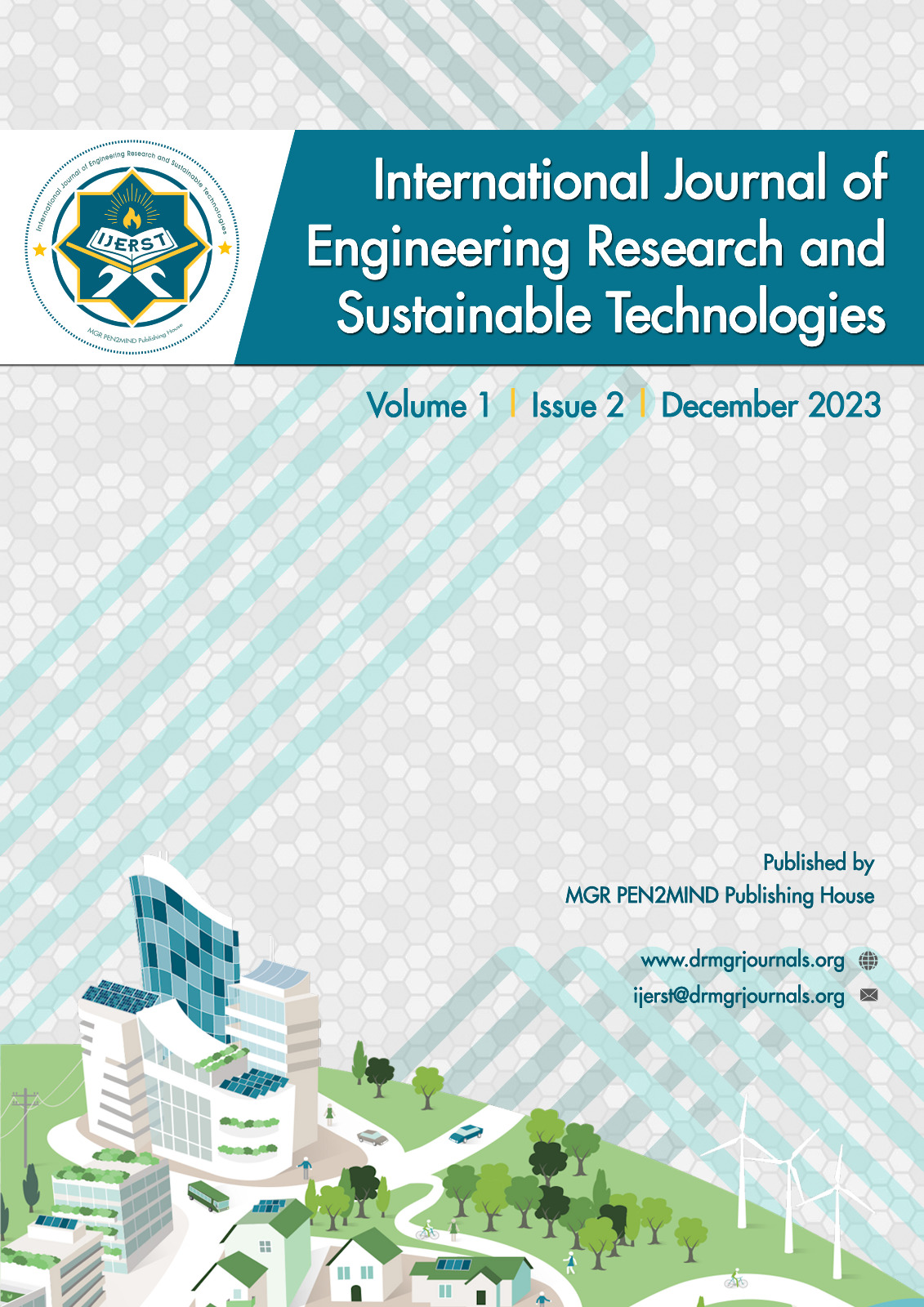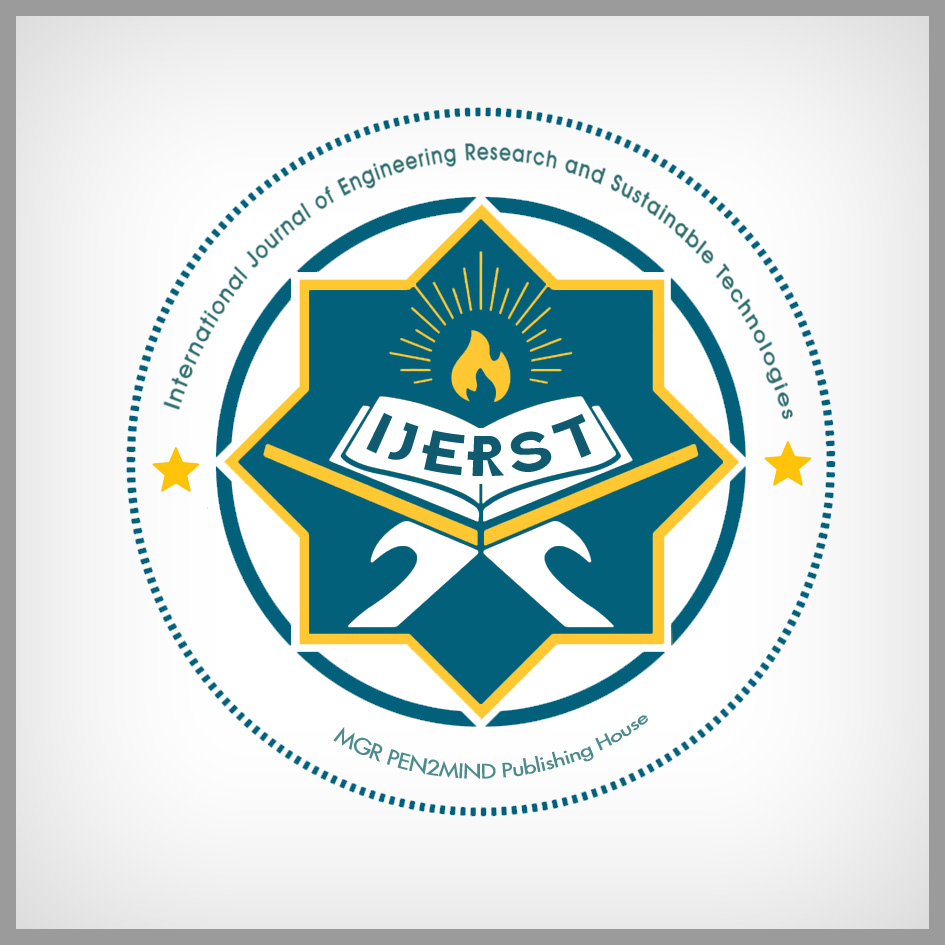AN EFFICIENT AIR QUALITY INDEX MONITORING AND PREDICTION SYSTEM USING FEMTO SAT TECHNOLOGY AND MACHINE LEARNING
DOI:
https://doi.org/10.63458/ijerst.v1i2.67Keywords:
Femto sat, LoRa Communication, Sensors, IOT, Air Pollution, AQI, MLAbstract
In recent times, the global population surge has led to a parallel increase in air pollution levels, posing significant threats to the economy, environment, and public well-being. Traditionally, air pollution is measured by placing sensors on buildings spaced a certain distance apart. Nevertheless, there are disadvantages to this strategy, such as higher power consumption for sensor operation in each house and restricted application in remote areas with inadequate infrastructure. Using satellite data from FEMTOSAT for autonomous air pollution monitoring, analysis and mitigation emerges as a ground-breaking solution to these problems. This innovative approach circumvents the limitations associated with traditional methods, offering a more comprehensive and versatile solution. FEMTOSAT leverages the capabilities of LoRa (Long Range) communication, a crucial component in the Internet of Things (IoT), enabling data transmission over extended distances while consuming minimal power. LoRa communication is essential to the FEMTOSAT installation because it makes information sharing between the satellite and ground stations easier. Data is transmitted and received using radio frequency (RF) impulses, which make for a dependable and effective form of communication. The Air Quality Index (AQI) for a particular place is then determined using the environmental data that was gathered by the satellite. An important metric for measuring air quality, the AQI provides information about the degree of pollution or cleanliness in a particular place. The AQI is determined by a number of factors, including the concentrations of pollutants including NO2, CO, O3, PM2.5, SO2, and PM10. Making use of machine learning (ML) techniques such as Support Vector Machines (SVM), direct regression, time series analysis and logistic regression to forecast and analyse AQI trends makes it very efficient. One of the distinctive features of this study is the development of AQI mappings, which are derived from the comprehensive AQI data collected at specific locations. It has been shown via thorough investigation that ML-based AQI prediction models are more consistent and dependable overall. Accuracy and precision have been ensured in the data collection process through the simplified integration of new technology and smart sensors. Only machine learning algorithms can manage the complex analysis needed to produce safe and reliable predictions from large datasets in the field of environmental monitoring. The main objective of this effort is exemplified by the integration of Integrated Sensors as the payload in the FEMTOSAT mission. The benefits of the system—such as its affordability, lightweight construction, resilience, redundancy and low power consumption—highlight FEMTOSAT's applicability and effectiveness in handling the intricate problems related to air pollution monitoring.
References
Brown, A. (no date) ‘Satellite measurements of air quality and greenhouse gases: application to regulatory activities’.
Gupta, N.S. et al. (2023) ‘Prediction of Air Quality Index Using Machine Learning Techniques: A Comparative Analysis’, Journal of Environmental and Public Health, 2023, p. e4916267. Available
at: https://doi.org/10.1155/2023/4916267. DOI: https://doi.org/10.1155/2023/4916267
Halsana, S. (2020) ‘Air Quality Prediction Model using Supervised Machine Learning Algorithms’, International Journal of Scientific Research in Computer Science, Engineering and Information Technology, pp. 190–201. Available at: https://doi.org/10.32628/CSEIT206435. DOI: https://doi.org/10.32628/CSEIT206435
Hill, T. et al. (1994) ‘Artificial neural network models for forecasting and decision making’, International Journal of Forecasting, 10(1), pp. 5–15. Available at: https://doi.org/10.1016/0169-2070(94)90045-0. DOI: https://doi.org/10.1016/0169-2070(94)90045-0
Holloway, T. et al. (2021) ‘Satellite Monitoring for Air Quality and Health’, Annual Review of Biomedical Data Science, 4(1), pp. 417–447. Available at: https://doi.org/10.1146/annurev-biodatasci-110920-093120. DOI: https://doi.org/10.1146/annurev-biodatasci-110920-093120
Iyer, D.R. and Turakhia, M.T. (no date) ‘ASSESSMENT OF AIR POLLUTION OF COLLEGE CAMPUS’.
Jha, R. (2020) ‘Air Quality Sensing and Reporting System Using IoT’, in, pp. 790–793. Available at: https://doi.org/10.1109/ICIRCA48905.2020.9182796. DOI: https://doi.org/10.1109/ICIRCA48905.2020.9182796
Kalaivani, G. and Mayilvahanan, P. (2021) ‘Air Quality Prediction and Monitoring using Machine Learning Algorithm based IoT sensor- A researcher’s perspective’, in 2021 6th International Conference on Communication and Electronics Systems (ICCES). 2021 6th International Conference on Communication and Electronics Systems (ICCES), pp. 1–9. Available at: https://doi.org/10.1109/ICCES51350.2021.9489153. DOI: https://doi.org/10.1109/ICCES51350.2021.9489153
Kleine Deters, J. et al. (2017) ‘Modeling PM2.5 Urban Pollution Using Machine Learning and Selected Meteorological
Parameters’, Journal of Electrical and Computer Engineering, 2017, p. e5106045. Available at: https://doi.org/10.1155/2017/5106045. DOI: https://doi.org/10.1155/2017/5106045
Kottur, S. and Mantha, S. (2015) ‘An Integrated Model using Artificial Neural Network (ANN) and Kriging for Forecasting Air Pollutants using Meteorological Data’, IJARCCE, pp. 146–152. Available at: https://doi.org/10.17148/IJARCCE.2015.4130. DOI: https://doi.org/10.17148/IJARCCE.2015.4130
Long, J.R. (no date) ‘LEVERAGING THE NPS FEMTO SATELLITE FOR ALTERNATIVE SATELLITE COMMUNICATION NETWORKS’.
Mani, G., Viswanadhapalli, J.K. and S, A.A. (2022) ‘Prediction and Forecasting of Air Quality Index in Chennai using Regression and ARIMA time series models’, Journal of Engineering Research, 10(2A), pp. 179–194. Available at: https://doi.org/10.36909/jer.10253. DOI: https://doi.org/10.36909/jer.10253
Palanichamy, N. et al. (2022) ‘Machine learning methods to predict particulate matter PM 2.5’, F1000Research, 11, p. 406. Available at: https://doi.org/10.12688/f1000research.73166.1. DOI: https://doi.org/10.12688/f1000research.73166.1
Pasupuleti, V.R. et al. (2020) ‘Air Quality Prediction Of Data Log By Machine Learning’, 2020 6th International Conference on Advanced Computing and Communication Systems (ICACCS), pp. 1395–1399. Available at: https://doi.org/10.1109/ICACCS48705.2020.9074431. DOI: https://doi.org/10.1109/ICACCS48705.2020.9074431
Remus, W. and O’Connor, M. (2001) ‘Neural Networks for Time-Series Forecasting’, in J.S. Armstrong (ed.) Principles of Forecasting: A Handbook for Researchers and Practitioners. Boston, MA: Springer US (International Series in Operations Research & Management Science), pp. 245–256. Available at: https://doi.org/10.1007/978-0-306-47630-3_12. DOI: https://doi.org/10.1007/978-0-306-47630-3_12
R.k, T. (2023) ‘FEMTOSAT-Based Air Quality Monitoring: Leveraging Satellite Data and LoRa Communication for Improved AQI Predictions’, Acceleron Aerospace Journal, 1(3), pp. 47–53. Available at: https://doi.org/10.61359/11.2106-2311. DOI: https://doi.org/10.61359/11.2106-2311
Siew, L.Y., Chin, L.Y. and Wee, P.M.J. (2008) ‘ARIMA AND INTEGRATED ARFIMA MODELS FOR FORECASTING AIR POLLUTION INDEX IN SHAH ALAM, SELANGOR’, 12(1).
Su, X. et al. (2021) ‘Intelligent and Scalable Air Quality Monitoring With 5G Edge’, IEEE Internet Computing, PP. Available at: https://doi.org/10.1109/MIC.2021.3059189. DOI: https://doi.org/10.1109/MIC.2021.3059189
V, S. et al. (2022) ‘Energy-Efficient Markov-Based Lifetime Enhancement Approach for Underwater Acoustic Sensor Network’, Journal of Sensors, 2022. Available at: https://doi.org/10.1155/2022/3578002. DOI: https://doi.org/10.1155/2022/3578002
Wu, T., Qu, D. and Zhang, G. (2019) ‘Research on LoRa Adaptability in the LEO Satellites Internet of Things’, 2019 15th International Wireless Communications & Mobile Computing Conference (IWCMC), pp. 131–135. Available at: https://doi.org/10.1109/IWCMC.2019.8766462. DOI: https://doi.org/10.1109/IWCMC.2019.8766462
Downloads
Published
How to Cite
Issue
Section
ARK
License
License Statement
This work is licensed under a Creative Commons Attribution 4.0 International License (CC BY 4.0).
Authors retain copyright of their articles and grant International Journal of Engineering Research in Science and Technology (IJERST) the right of first publication.
This license permits unrestricted use, distribution, and reproduction in any medium, provided the original author and source are credited.
The journal encourages open access and supports the global exchange of knowledge.





